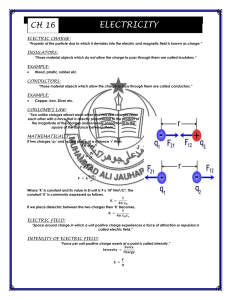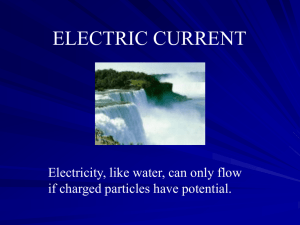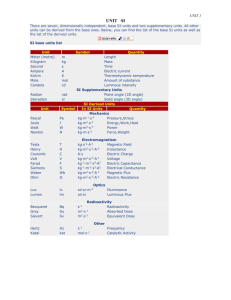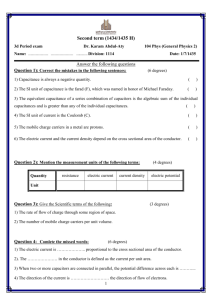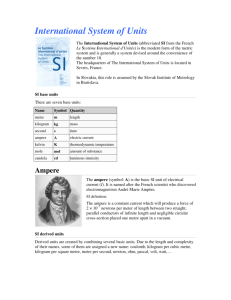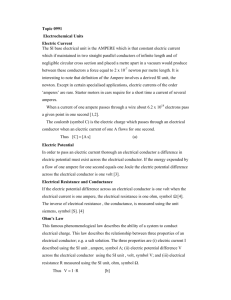CH#16_Electricity
advertisement
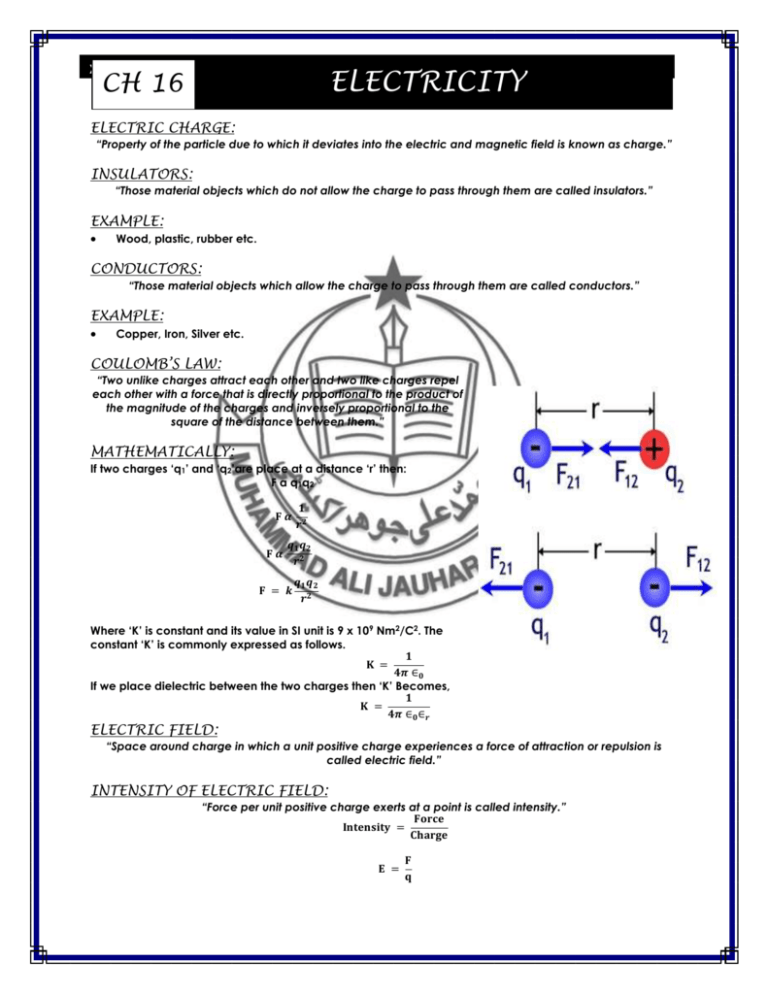
ELECTRICITY X-PHYSICS CH 16 FAHAD AKHTER ELECTRIC CHARGE: “Property of the particle due to which it deviates into the electric and magnetic field is known as charge.” INSULATORS: “Those material objects which do not allow the charge to pass through them are called insulators.” EXAMPLE: Wood, plastic, rubber etc. CONDUCTORS: “Those material objects which allow the charge to pass through them are called conductors.” EXAMPLE: Copper, Iron, Silver etc. COULOMB’S LAW: “Two unlike charges attract each other and two like charges repel each other with a force that is directly proportional to the product of the magnitude of the charges and inversely proportional to the square of the distance between them.” MATHEMATICALLY: If two charges ‘q1’ and ‘q2’are place at a distance ‘r’ then: F α q1q2 𝐅𝜶 𝐅𝜶 𝟏 𝒓𝟐 𝒒𝟏 𝒒𝟐 𝒓𝟐 𝐅 = 𝒌 𝒒𝟏 𝒒𝟐 𝒓𝟐 Where ‘K’ is constant and its value in SI unit is 9 x 109 Nm2/C2. The constant ‘K’ is commonly expressed as follows. 𝟏 𝐊 = 𝟒𝝅 ∈𝟎 If we place dielectric between the two charges then ‘K’ Becomes, 𝟏 𝐊 = 𝟒𝝅 ∈𝟎 ∈𝒓 ELECTRIC FIELD: “Space around charge in which a unit positive charge experiences a force of attraction or repulsion is called electric field.” INTENSITY OF ELECTRIC FIELD: “Force per unit positive charge exerts at a point is called intensity.” 𝐅𝐨𝐫𝐜𝐞 𝐈𝐧𝐭𝐞𝐧𝐬𝐢𝐭𝐲 = 𝐂𝐡𝐚𝐫𝐠𝐞 𝐄 = 𝐅 𝐪 X-PHYSICS FAHAD AKHTER UNIT: S.I unit of charge is Newton/Coulomb (N/C). ELECTROSTATIC INDUCTION: “Change in the distribution of charge of neutral body due to the presence of charged body is called electrostatic induction.” GOLD LEAF ELECTROSCOPE: “It is a device used to detect charge.” CONSTRUCTION: It consists of a glass case which contains two thin gold leaves which are connected to metal ball outside the case through a conductor. Working: If a charge object brought close to the ball, separation of charge is induced between the ball and gold leaves. The two leaves become charge and repel each other. The nature of the charge can be determined by bringing it near a charged electroscope. ELECTRIC POTENTIAL: “The work done in moving a unit positive charge from one point to the other against electric intensity is called electric potential.” 𝐖𝐨𝐫𝐤 𝐝𝐨𝐧𝐞 𝐄𝐥𝐞𝐜𝐭𝐫𝐢𝐜 𝐩𝐨𝐭𝐞𝐧𝐭𝐢𝐚𝐥 = 𝐂𝐡𝐚𝐫𝐠𝐞 𝐕 = 𝐖 𝐪 UNIT: S.I unit of Electric potential is Joule/Coulomb (J/C) or Volts (V). VOLT: “Potential difference between two points is one volt when one joule work is required to move one coulomb charge from one point to the other.” CAPACITOR: “The device which is used for storing electric charge is called capacitor.” CONSTRUCTION: Typical capacitor consist of two parallel plates placed on insulating stand and are separated by some insulating material known as dielectric. The charge stored in the capacitor is directly proportional to the potential difference ‘V’ across the plates of capacitor. QαV Q = CV Where ‘C’ is constant called capacitance of capacitor. CAPACITANCE OF CAPACITOR: “The charge stored per unit potential difference between the plates of capacitor is called capacitance of capacitor.” 𝐂𝐨𝐮𝐥𝐨𝐦𝐛 𝐂𝐚𝐩𝐚𝐜𝐢𝐭𝐚𝐧𝐜𝐞 = 𝐕𝐨𝐥𝐭 X-PHYSICS FAHAD AKHTER 𝐂 = UNIT: 𝐂𝐨𝐥. 𝐕 S.I unit of capacitance is Coulomb/Volt (Col. /V) or Farad. FARAD: “The capacitance of a capacitor is one farad if a charge of one coulomb produces a potential difference of one volt between the plates of the capacitor” 1micro farad (1μF) = 10-6 Farad 1micro- micro farad (1μμF) = 10-12 Farad FACTOR AFFECTING THE CAPACITY OF CAPACITANCE: 1. Area of the plates: Greater the area of the plates, greater will be the capacity. 2. Distance between the two plates: Lesser the distance between the plates greater will be the capacity. 3. Nature of dielectric: If we use glass in place of air as dielectric then capacity will increase. ELECTRO-MOTIVE FORCE (E.M.F): “Energy required to derive charge around the circuit is called Electro-Motive Force.” 𝐄. 𝐦. 𝐟 = 𝐄𝐧𝐞𝐫𝐠𝐲 𝐬𝐮𝐩𝐩𝐥𝐢𝐞𝐝 𝐂𝐡𝐚𝐫𝐠𝐞 UNIT: S.I unit of E.M.F Volt. ELECTRIC CURRENT: “Rate of flow of electric charge under the influence of applied electric field is called electric current.” It is denoted by ‘I’. 𝐂𝐡𝐚𝐫𝐠𝐞 𝐄𝐥𝐞𝐜𝐭𝐫𝐢𝐜 𝐜𝐮𝐫𝐫𝐞𝐧𝐭 = 𝐓𝐢𝐦𝐞 𝐐 𝐈 = 𝐭 UNIT: S.I unit of Electric current is Coulomb/Second or Ampere. AMPERE: “If one coulomb of charge flowing through a cross-section of a conductor in one second then current is one ampere” 1milliampere = 10-3 Ampere 1micro- Ampere (1μAmp) = 10-6 Ampere TYPES OF CURRENT: ALTERNATING CURRENT: “A current which alternates or reverse its direction several times per second is called an alternating current. It is denoted by A.C.” X-PHYSICS FAHAD AKHTER DIRECT CURRENT: “A current which does not change its direction in the circuit with the time, is called direct current. It is denoted by D.C.” RESISTANCES: “Resistances are a measure of apposition to the motion of free electron (i.e. current) due to there continues collision with the atoms of lattice of conductor.” UNIT: Unit of resistance is ohm (Ώ). DEFINITION OF ONE OHM: “The resistance of a column of mercury of length 106.3 cm having a uniform cross section of one square mille meter and weighing 14.4521 g at 𝟎𝟎 C is one ohm.” One kilo ohm (1k Ώ) = 1000 ohm (𝟏𝟎𝟑 Ώ) One mega ohm (1M Ώ) = 1000000 ohm (𝟏𝟎𝟔 Ώ) OHM’S LAW: “The potential difference between the two ends of the conductor is directly proportional to the current passing through it provided there is no change in the physical state of the conductor.” MATHEMATICALLY: Suppose current 'I’ is passing through a conductor and the potential difference between the two ends of conductor is V then VαR V = IR Where ‘R’ is known as resistance of conductor. ELECTRIC CIRCUIT: “Any closed path through which an electric current can flow is called electric circuit.” In electric circuit resistance can be connected in the following two ways: Series combination. Parallel combination. SERIES COMBINATION: “Resistors are said to be connected in series when they are connected end to end consecutively so that there is only one path for the flow of current and the same current flow through each resistors.” MATHEMATICALLY: Let three resistances R1, R2 and R3 are connected in series across a battery of voltage’s’. The potential difference across each resistor is V1, V2, and V3 respectively, According to ohm’s law: V1 = IR1 V2 = IR2 V3 = IR3 As total voltage of the battery, V =V1 + V2 +V3 IR = IR1 + IR2 + IR3 IR = I (R1 + R2 + R3) R = R1 + R2 + R3 If ‘n’ resistors are connected then, R = R1 + R2 + R3 +.......+ Rn X-PHYSICS FAHAD AKHTER CHARACTERISTICS OF SERIES COMBINATION: 1. 2. 3. 4. Only one path is available for the flow of current. Same current passing through each resistor. Potential difference of the source is equal to the sum of potential difference across each resistor. The resistance R1, R2 and R3 can be replaced by a single resistance R. PARALLEL COMBINATION: “Resistors are said to be connected in series when each of them is connected between the two common points.” MATHEMATICALLY: Resistances R1, R2, R3 are connected in parallel between the two points. A battery of voltage ‘V’ is connected. The main current ‘I’ coming from the battery is divided into I1, I2, and I3 among the resistors R1, R2, R3 respectively. The potential difference across each resistor remains same. The sum of their currents is equal to, I = I1 + I2 + I3---------- (1) According to ohm’s law, 𝐈 = 𝐕 , 𝐑 𝐈𝟏 = 𝐕 𝐕 , 𝐈 = , 𝐑𝟏 𝟐 𝐑𝟐 𝐈𝟑 = 𝐕 𝐑𝟑 Substituting the value of I, I1, I2, I3 we get, 𝐕 𝐕 𝐕 𝐕 = + + 𝐑 𝐑𝟏 𝐑𝟐 𝐑𝟑 𝐕 𝟏 𝟏 𝟏 = 𝑽( + + ) 𝐑 𝐑𝟏 𝐑𝟐 𝐑𝟑 𝟏 𝟏 𝟏 𝟏 = + + 𝐑 𝐑𝟏 𝐑𝟐 𝐑𝟑 If ‘n’ resistors are connected then, 𝟏 𝟏 𝟏 𝟏 𝟏 = + + ………+ 𝐑 𝐑𝟏 𝐑𝟐 𝐑𝟑 𝐑𝐧 CHARACTERISTICS OF PARALLEL COMBINATION: 1. 2. 3. 4. Many paths available for the flow of current. Current passing through every resistor can be different. Sum of all such currents is equal to the total current supplied by the battery. Potential difference across each resistor will be the potential difference of the source. Hence the resultant resistance of the circuit will be equal to the sum of reciprocals of all the resistance in the circuit. JOULE’S LAW: “The amount of work done is directly proportional to the amount of heat produced.” X-PHYSICS FAHAD AKHTER MATHEMATICALLY: Work done α Amount of heat Suppose charge ‘Q’ coulombs is passing through a resistance ‘R’ in time‘t’ second when potential difference of ‘V’ volts is maintained across its ends. Work = VQ Since Q = It W = VIt According to Ohm’s law V = IR W = (IR) It W = I2Rt POWER: “Rate of doing work is called power.” MATHEMATICALLY: 𝐏𝐨𝐰𝐞𝐫 = 𝐖𝐨𝐫𝐤 𝐓𝐢𝐦𝐞 𝐏𝐨𝐰𝐞𝐫 = 𝐖 𝐭 According to Joule’s law W = I2Rt 𝐏𝐨𝐰𝐞𝐫 = 𝐈𝟐 𝐑𝐭 𝐭 Power = I2R Power = I x (IR) Since V = IR Power = IV UNIT: Unit of Power Watt. WATT: “If one joule of electric work is done in one second then the power is called one watt” Commercial unit of Electrical energy is kilo-watt per hour.(Kwh) KILO-WATT HOUR: “When a power of one kilo-watt is maintained for one hour then electric energy is kilo-watt hour.” HOUSE CIRCUIT: Electricity is usually comes to our home by two wires, the live (L) and the neutral (N). The potential difference between these wires is 220V. The neutral wire is connected to the earth about every 100 meter. The potential on the live wire is alternately positive and negative with respect to the neutral wire. X-PHYSICS FAHAD AKHTER FUSE: “It is an electrical device generally uses to save the electric appliances from the hazards of potential changes.” CH 16 1. MULTIPLE CHOICE QUESTIONS (MCQ’S) Equivalent to joules per coulomb. i) Ampere ii) Ohm iii) Volt iv) Watt 2. 1 mega ohm resistance is i) 106 ii) 10-6 iii) 108 ohm. iv) 102 3. Electrical power in watt is obtain by the product of i) Volt and coulomb ii) Current and resistance v) 10-8 . iii) Volt and Ampere 4. Is that which connected in series with the line wires in circuit of house. i) Galvanometer ii) Voltmeter iii) Fuse iv) Ammeter 5. The substance use as a medium between the two plates of a capacitor is known as i) Conductor ii) Semi-conductor iii) Di-electric iv) Electrolyte 6. The value of constant that occurs in coulomb’s force formula is i) 9 x 10-9 ii) 9 x 10-16 iii) 9 x 109 iv) 9.9 x 10-9 N-m2/col2. 7. Three resistors of three ohm each connected in parallel have a combine resistance of i) 1 ii) 9 iii) 27 8. 1 micro-ampere equal to i) 10-2 ii) 10-3 iii) 10-6 Ampere. 9. 1 micro-Coulomb equal to i) 10-6 ii) 10-9 iii) 10-12 coulomb. 10. The unit of capacitance is i) Coulomb ii) Farad . iii) Ohm CH 16 . ohm. PAST TEN YEARS QUESTIONS (2003) Q: Write down any two point difference between each of the following: I) Direct current & Alternating current. Q: Find the potential difference between the two ends of a conductor, if it offers a resistance of 5 ohm when a current of 5 amps passes through it. Q: Define the following terms: I) Ampere II) Farad. (BLANK): The charge flow through a conductor in unit time is called Current. (2004) Q: Define the following: I) Coulomb II) Q: What is capacitor? Write the factor on which its capacitance depends. (BLANK): One micro farad = 10-6 farad. Q: A 100 watt bulb operates in a 220 volts circuit. Find the current passing through it. (2005) Q: Write down any two points of difference between the following. I) Insulator and conductor. X-PHYSICS FAHAD AKHTER Q: Draw a diagram of series and parallel combination of resistance and write down two characteristics of the resistance connected in parallel Q: Find the resistance of an electric bulb is a 0.6A current is passing through it and the potential difference across the bulb is 90 V. (BLANK): An ammeter is always connected in series to measure the current in circuit. (2006) Q: Define the following terms: I) Farad. Q: What is the current through a conductor with a resistance of 19 ohms when the potential difference across it is 12V? Q: The commercial unit of electrical energy is kilowatt hour. Q: State the following laws: I) Ohm’s Law II) Coulombs law III) Joule’s law. (2007) Q: Define the following: I) Ampere II) Fuse. (BLANK): Joules/Coulomb is the unit of Potential difference. Q: Write down the point difference between the following: I) Direct current & Alternating current. Q: Find the potential difference between the two ends of a conductor if its resistance is 5 ohm and a current of 500 mill ampere is passing through it. (2008) (BLANK): One mill ampere is equal to 10-3 ampere. Q: Define the following: I) Farad (BLANK): The device which collects the charges is called Capacitor. (BLANK): The substance used as a medium between the two plates of a capacitor is called Dielectric. Q: Write down the point difference between the following: I) Direct current & Alternating current. Q: Define coulomb’s law and derive its formula? Q: Find the current through the heater which has a resistance of 20 ohms and a potential difference of 220V is supplied to it. (2009) Q: Define the following: I) Direct current. Q: The unit of charge is coulomb. Q: State and explain the coulomb’s law and derive the equation F = Kq1q2/r2. Q: Find the potential difference between the two ends of a conductor if its resistance is 5 ohm and a current of 500 mill ampere is passing through it. (BLANK): The unit of current is Ampere. Q: Write down the three characteristics of resistance join in series and draw the diagram of series resistance. (2010) Q: A 100 watt bulb operates in 220V circuit. Find the current through the bulb. Q: What is an electric capacitor? Write down three factors upon which its capacitance depends. (2011) Q: Calculate the amount of current passing through an electric heater if it takes 1800C of charge. (2012) Q: Define the following: I) Alternating current (A.C) II) Electric field III) Electrostatic induction. Q: Drive the relation W = I2Rt. Q: Find the resistance of bulb if 0.6 Amp current is passing through the bulb and the potential difference across the bulb is 90 volt. Q: write down any three characteristics of resistances connected in parallel. Q: Define the capacity of capacitor. Write down three factors upon which capacity of capacitor depends. Q: Define coulombs law. Derive the equation F = Kq1q2/r2 He who cultivates for bad habits always remains sad.

